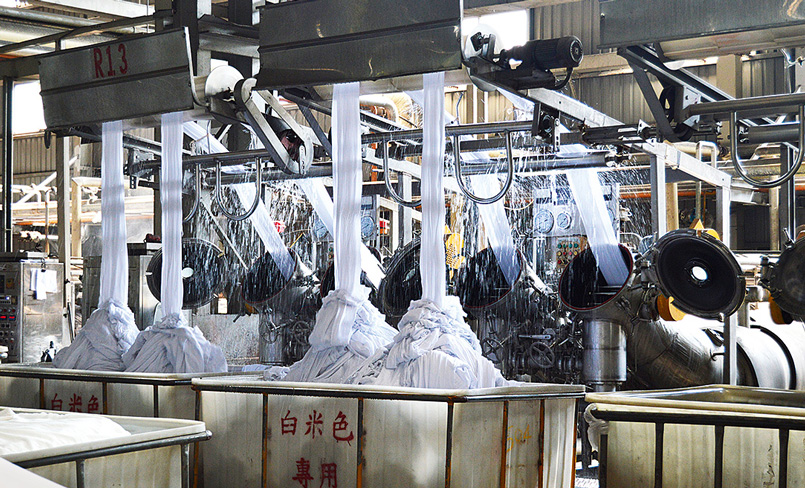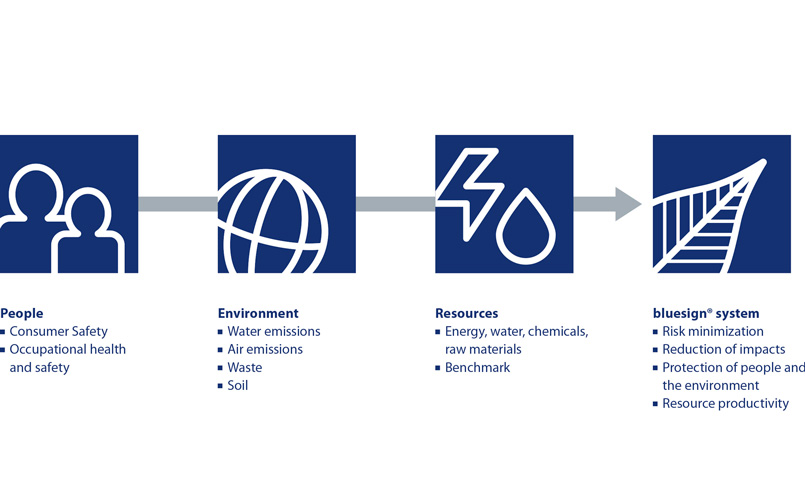
June 9, 2018 Bluesign: Born in Crisis
The bluesign® system has become the industry’s highest standard for safe, sustainable and efficient manufacturing in the textile supply chain. While the label bluesign is well-known in the industry and end consumers have begun to recognize the label, few know the fascinating story of how it came to be.
Awareness of the social and environmental impacts of chemicals was long in coming. Lake Constance for example, just east of bluesign’s head office in St.Gallen, Switzerland, had been a textiles hub for hundreds of years with over 2,000 textile mills encircling its shores. Yet as the textiles industry thrived, the lake’s waters slowly became virtually devoid of life.
It’s been said that only an acute crisis can lead to real change. On the morning of November 1, 1986, a chemicals storehouse containing pesticides, solvents and dyes along the Rhine’s riverbank caught fire. As firefighters tried to battle the blaze, 30 tons of toxic chemicals entered Europe’s most important waterway, thereafter passing through four countries and finally emptying into the North Sea. Though the cause of the fire was never determined, its consequences were all too clear.
When the people living along the Rhine awoke to the apocalyptic scene of a toxic, blood-red flow moving down the river killing everything in its path, the wheels of change were inexorably set in motion. In the aftermath of this catastrophe, sweeping legislation was passed in Switzerland and elsewhere where for the first time, industries’ handling of chemicals was heavily regulated, and they were now charged for pollution. This was nothing less than a game changer for the local textile industry, whereby among other things this increased wastewater costs by a factor of about five.
The textile company that later would start bluesign was forced to either adapt or die. Fortunately, they achieved the former. Over the years that followed, they increasingly acquired and systematized know-how on how to improve efficiency and remove hazardous chemicals from their manufacturing processes in a way that began to spare them on costs as well as reduce their exposure to risks. It soon became clear that this know-how could provide an invaluable service to others in the industry, and in the year 2000 bluesign technologies ag was born.



Pioneers in chemical management
Drawing on the expertise of an interdisciplinary team of chemical and textiles industry consultants, bluesign set out with the mission to link chemical suppliers, textile manufacturers and brands together to foster a healthy, responsible and profitable textile industry. The response? Let’s just say back in 2000 this fledgling consultancy company wasn’t exactly met with open arms. Awareness of the problems bluesign was able to solve was still in its infancy, and at first nobody quite seemed to understand what bluesign was offering.
Meanwhile, in the outdoor industry, brands and retailers were being met by increasingly concerned, conscious customers who wanted to know whether their outdoor garments were contributing to environmental and social problems. At the time, brands and retailers had no real way of assuring them that they did not. Until they met bluesign, that is. It was here, in the outdoor industry, that bluesign was able to find its first foothold and prove that its Input Stream Management approach could indeed be applied to complex global supply chains.
From here the rings have spread. Aside from the outdoor industry, bluesign’s logo has since proliferated in sportswear and it’s making headway into an increasingly social and environmentally conscious fashion industry. The fish have since returned to Lake Constance and the Rhine River’s recovery is well underway.
A happy ending?
Not quite yet. Of course, many of the textile industry’s problems have not been eliminated, they’ve simply been outsourced. Yet in a globalized world, out of sight is no longer out of mind, and as consumers’ awareness increases so too do their demands. It is an understatement to say that cleaning up the global, complex supply chain of today’s textiles industry is difficult, but bluesign’s track record demonstrates that it can be done with the right support.
The textiles industry remains one of the biggest polluters on the planet and consumer demands for sustainability is beginning to weigh in, making bluesign more relevant today than ever before.
How does bluesign® work?
Bluesign provides a holistic solution for safe and environmentally friendly textile production, working at each step of the supply chain to ensure that products meet rigorous benchmarks with focus on people, the environment and resources.
 The bluesign system
The bluesign system
Many certifications focus on the end product, but this says nothing about substances or practices used in the previous stages of production. The solution is simply to turn this approach upside down: start at the beginning. By preventing hazardous chemicals from entering the input stream in the first place, the bluesign system creates a clean process that provides consumers the confidence they are purchasing a product that is both sustainably produced and that meets the highest consumer safety standards. This is the bluesign Input Stream Management approach.
Since its founding in 2000, bluesign has used scientific chemical assessments to evaluate the hazards of 20,000 chemical formulations and assign them to one of three categories: blue – safe to use; gray – special handling required; and black – forbidden. The assessments relate to over 900 different chemical substances, whereas 600 banned substances are included. Yet it’s not enough to merely point out which chemicals to avoid – manufacturers need good and safe alternatives.
That’s why bluesign created the first and most comprehensive positive list in the industry, outlining over 11,000 safe and effective alternative chemicals in what’s known as the bluesign blue finder.

Cooperation with system partners
Together with system partners, bluesign’s industry experts prepare a roadmap for the company to meet the benchmarks on the focus areas. Once achieved, the system partner may then use the bluesign trademark on the applicable product, one made with minimal negative social and environmental impacts.
But it doesn’t end here. While the right to use the bluesign logo is certainly a milestone along the journey, it’s not the final destination. That’s because bluesign offers more than a standard, it provides an active and growing industry forum where its over 500 system partners together find ways on collaborating on some of the industry’s most pressing sustainability challenges.
This is the blue way.
The fifth bluesign® conference takes place October 18–19 2018, Milan, Italy












